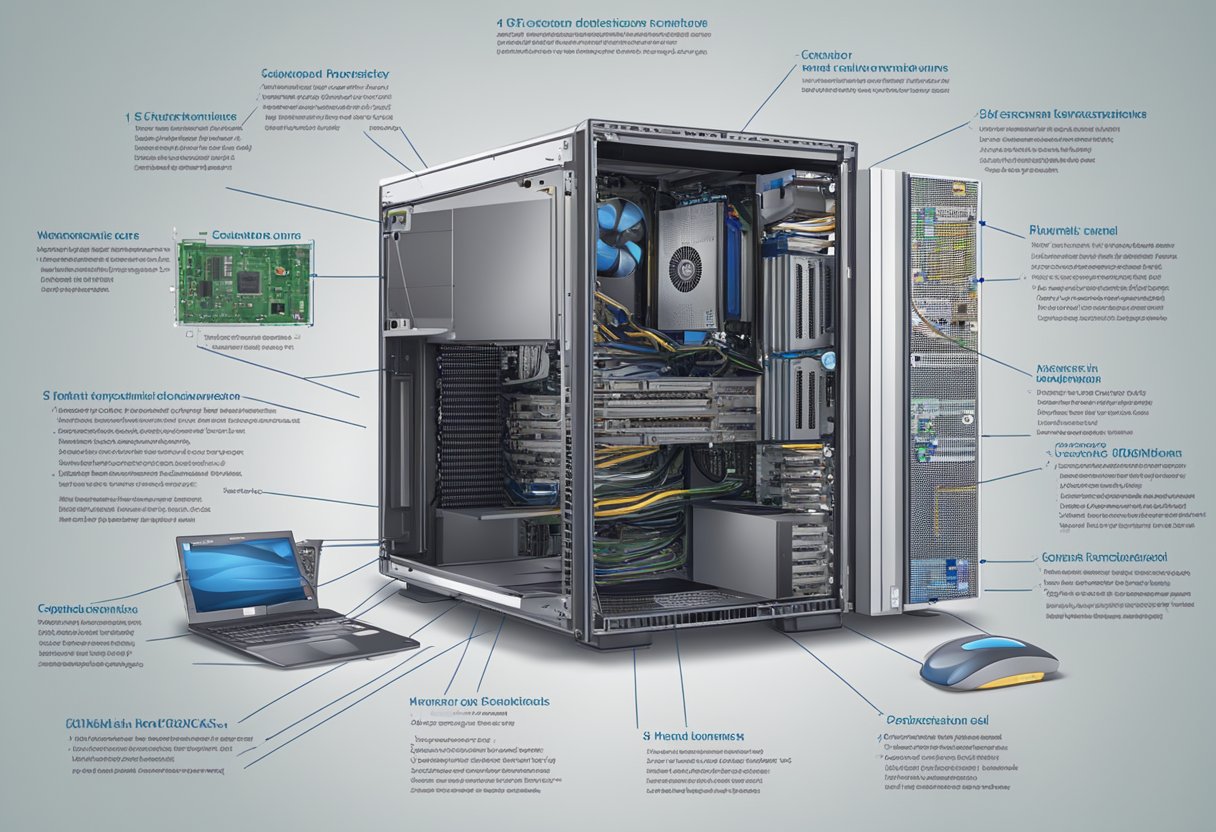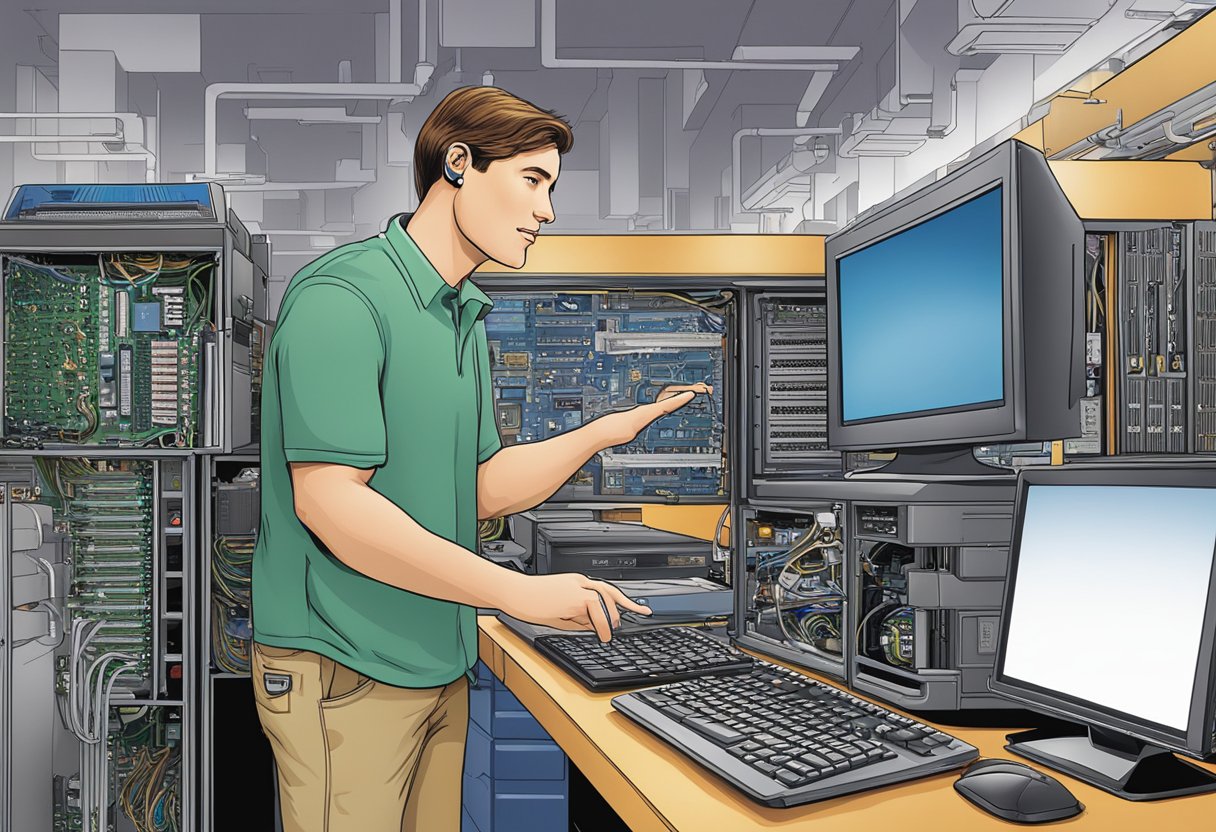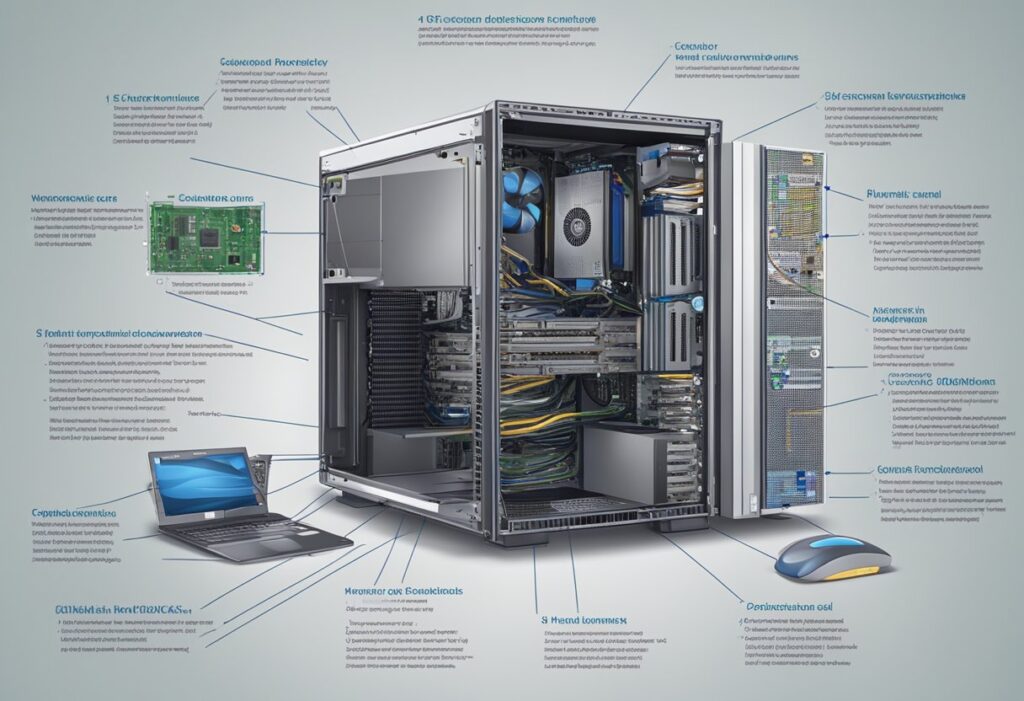Computer hardware issues can be frustrating and time-consuming to troubleshoot. From malfunctioning keyboards to faulty graphics cards, hardware problems can disrupt work and cause stress. However, understanding the basics of computer hardware and how to identify and fix common issues can save time and money in the long run.

One of the first steps in troubleshooting computer hardware issues is identifying the problem accurately. This can involve checking cables, restarting the computer, and running diagnostic tests. Knowing how to identify specific hardware components and their functions can also be helpful in pinpointing the issue and finding a solution.
While some hardware issues may require professional assistance, many can be resolved with basic troubleshooting techniques. This guide will provide essential tips and step-by-step instructions for identifying and fixing common computer hardware problems. Whether you are a seasoned computer user or a novice, this guide will equip you with the knowledge and skills needed to tackle hardware issues with confidence.
Understanding Computer Hardware
https://www.youtube.com/watch?v=VQPxFFMCxgQ&embed=true
Computer hardware refers to the physical components that make up a computer system. These components can be installed inside or connected to the outside of a computer. Understanding computer hardware is essential for troubleshooting and upgrading a computer system.
Hardware components can be divided into two categories: internal and external. Internal components are installed inside the computer case, while external components are connected to the outside of the computer. Internal components include the motherboard, CPU, RAM, hard drive, power supply, and expansion cards. External components include the keyboard, mouse, monitor, printer, and speakers.
The motherboard is the main circuit board of a computer system. It connects all the internal components and provides communication between them. The CPU, or central processing unit, is the brain of the computer and performs all the calculations and operations. RAM, or random access memory, is the temporary storage space for data that the CPU is currently using. The hard drive is the permanent storage space for all files and data on the computer.
Power supply is responsible for providing power to all the components in the computer. Expansion cards are used to add extra functionality to the computer system, such as a graphics card for better visuals or a sound card for better audio.
When troubleshooting computer hardware issues, it is important to identify which component is causing the problem. For example, if the computer does not turn on, it could be a power supply or motherboard issue. If the computer is running slow, it could be a RAM or hard drive issue.
Overall, understanding computer hardware is crucial for maintaining and upgrading a computer system. By identifying and fixing hardware issues, users can ensure that their computer is running at its best.
Identifying Common Hardware Problems
https://www.youtube.com/watch?v=L2E7vpj3Iq8&embed=true
When a computer starts experiencing issues, it’s essential to identify what’s causing the problem. Some common hardware problems include overheating, blue screen of death, computer freezes, and error messages.
One of the most common hardware problems is overheating. If a computer is overheating, it can cause the system to slow down, freeze, and even shut down. Users can check if their computer is overheating by feeling the temperature of the computer or checking the CPU temperature using software tools. If the computer is overheating, users can try closing unused applications, check the fan is working properly, and conduct a good dusting after the computer is turned off before trying other solutions for an overheating PC.
Another common hardware problem is the blue screen of death (BSOD). A BSOD is a critical system error that can cause a computer to shut down or restart unexpectedly. BSODs can be caused by hardware or software issues. Users can try to identify the cause of the BSOD by checking the error message that appears on the screen. Some common causes of BSODs include faulty RAM, hard drive issues, and driver problems.
Computer freezes are another common hardware problem. A computer freeze occurs when the system stops responding, and the user is unable to perform any actions. Computer freezes can be caused by hardware or software issues. Users can try to identify the cause of the computer freeze by checking if the computer is overheating, checking for driver issues, and checking for malware or virus infections.
Finally, error messages are a common hardware problem. Error messages can be caused by hardware or software issues. Users can try to identify the cause of the error message by checking the error code and message. Some common causes of error messages include hard drive issues, faulty RAM, and driver problems.
Overall, identifying common hardware problems is essential for troubleshooting computer issues. Users can try to identify the cause of the problem by checking for overheating, BSODs, computer freezes, and error messages.
Components and Their Issues
https://www.youtube.com/watch?v=ExxFxD4OSZ0&embed=true
When it comes to computer hardware issues, there are a few common components that are often the root of the problem. In this section, we will discuss some of the most common issues related to the motherboard, CPU, memory, storage, and peripheral devices.
Motherboard and CPU Issues
The motherboard is the backbone of a computer, and any issues with it can cause a range of problems. One common issue is a faulty power supply unit (PSU) that can cause the computer to shut down unexpectedly or fail to start up at all. Another issue is a faulty logic board, which can cause the computer to freeze or crash.
The CPU is the brain of the computer, and any issues with it can cause the computer to slow down or fail to start up. One common issue is overheating, which can be caused by a faulty fan or inadequate cooling. Another issue is a faulty power button or power cable, which can prevent the computer from turning on.
Memory and Storage Problems
Memory (RAM) and storage are essential components of a computer, and any issues with them can cause the computer to slow down or fail to start up. One common issue is a lack of hard drive space, which can cause the computer to run slowly or freeze. Another issue is a faulty hard drive or solid-state drive (SSD), which can cause the computer to fail to start up or crash.
Peripheral Device Challenges
Peripheral devices such as keyboards, mice, printers, scanners, monitors, and speakers can also cause issues with a computer. One common issue is a faulty USB port, which can prevent devices from being recognized or cause them to malfunction. Another issue is a faulty peripheral device, which can cause the computer to freeze or crash.
In summary, computer hardware problems can be caused by a range of components, including the motherboard, CPU, memory, storage, and peripheral devices. By understanding these issues and how to troubleshoot them, users can keep their computers running smoothly and avoid costly repairs.
Software and Operating System Interactions
https://www.youtube.com/watch?v=PSnGuvylWBI&embed=true
The interaction between software and operating system is crucial to the proper functioning of a computer. The operating system is responsible for managing the computer’s hardware and software resources. It provides a common set of controls for managing computer hardware, making it easier for users to interact with computers and for programmers to write application software.
One of the most important aspects of software and operating system interaction is device drivers. Device drivers are small programs that allow the operating system to communicate with hardware devices such as printers, scanners, and cameras. Without device drivers, the operating system would not be able to interact with these devices, and they would be useless.
Another important aspect of software and operating system interaction is virus scanning. Virus scanning software is designed to detect and remove viruses and other malicious software from a computer. The operating system interacts with virus scanning software to ensure that the computer is protected from these threats.
Windows 10 is a popular operating system that is widely used by many computer users. It provides a range of features and tools that allow users to manage their computer hardware and software resources effectively. Windows 10 also includes built-in virus scanning software, Windows Defender, which provides a basic level of protection against viruses and other malicious software.
In conclusion, software and operating system interaction is critical to the proper functioning of a computer. Device drivers and virus scanning software are two important aspects of this interaction. Windows 10 provides a range of features and tools that make it easier for users to manage their computer hardware and software resources effectively.
Troubleshooting Techniques
https://www.youtube.com/watch?v=tKrkoxrY2wc&embed=true
When it comes to troubleshooting computer hardware issues, there are a few techniques that can help identify and solve the problem. One of the most important techniques is the process of elimination. This means identifying all possible causes of the issue and ruling them out one by one until the root cause is found.
Another useful technique is checking the device manager. This tool allows users to view all the hardware installed on their computer and identify any issues or conflicts. If a hardware component is malfunctioning, it may appear with a yellow exclamation mark or red X in the device manager.
If the issue is not immediately apparent, restarting the computer is a good first step. This can solve many basic issues and reset any hardware components that may be causing problems. Additionally, checking for loose connections or cables can help ensure that all hardware is properly connected and functioning correctly.
If the issue persists, it may be necessary to test individual hardware components. This can involve running diagnostic software or physically testing components such as memory or hard drives. In some cases, it may be necessary to replace a faulty component to fully resolve the issue.
Overall, troubleshooting computer hardware issues requires a methodical and patient approach. By using techniques such as the process of elimination and device manager checks, users can identify and resolve issues in a timely and effective manner.
Maintenance, Upgrades, and Repairs
https://www.youtube.com/watch?v=FOaNQcISKh8&embed=true
Regular maintenance, upgrades, and repairs are essential to keep a computer running smoothly and extend its lifespan. Here are some tips to help ensure optimal performance:
Maintenance
Regular maintenance can help keep a computer running smoothly. Here are some maintenance tasks to consider:
- Wipe down the monitor with a dry lint-free cloth once a week to keep it clean and fresh.
- Keep the computer case clean and free of dust by using compressed air or a soft-bristled brush to remove any buildup.
- Check cables and connections to ensure they are secure and not damaged.
- Replace the CMOS battery on the motherboard every few years to prevent data loss and ensure proper system operation.
- Keep the bridge between the CPU and the heatsink clean and free of dust and debris to prevent overheating.
- Remove any unused software and files from the computer to free up space and improve performance.
Upgrades
Upgrading certain hardware components can improve a computer’s performance. Here are some upgrades to consider:
- Adding more RAM can help improve system performance and speed up applications.
- Upgrading the hard drive to a solid-state drive (SSD) can significantly improve boot times and application load times.
- Installing a dedicated graphics card can improve the computer’s ability to handle graphics-intensive tasks, such as gaming or video editing.
- Upgrading the CPU can also improve system performance, but this can be a costly and complex process.
Repairs
If a computer is not functioning properly, repairs may be necessary. Here are some common repairs:
- Replacing a faulty power supply can resolve issues with the computer not turning on or shutting down unexpectedly.
- Replacing a failing hard drive can prevent data loss and restore proper system operation.
- Replacing a faulty floppy disk drive can resolve issues with the computer not recognizing floppy disks.
In conclusion, regular maintenance, upgrades, and repairs are essential to keep a computer running smoothly and extend its lifespan. By following these tips, users can help ensure optimal performance and avoid costly repairs in the future.
Frequently Asked Questions

What are some common hardware problems that can cause computer issues?
Hardware problems can cause a range of computer issues, including slow performance, freezing, crashing, and failure to start up. Some common hardware problems include malfunctioning hard drives, faulty RAM, overheating components, damaged power supplies, and broken motherboards.
What are the steps for troubleshooting computer hardware problems?
When troubleshooting computer hardware problems, it is important to follow a systematic approach. The first step is to identify the problem, then gather information about the hardware and software involved. Next, perform basic checks, such as ensuring all cables are properly connected, and checking for signs of physical damage. If the problem persists, try updating drivers and firmware, running diagnostic tests, and replacing faulty components.
What are some examples of hardware troubleshooting?
Hardware troubleshooting can involve a range of tasks, such as checking for loose connections, running diagnostic tests, updating drivers and firmware, and replacing faulty components. For example, if a computer is overheating and shutting down unexpectedly, hardware troubleshooting might involve cleaning the fans and vents, replacing the thermal paste, and checking the power supply.
How can I identify hardware problems in my computer?
There are several signs that may indicate a hardware problem in a computer. These include slow performance, freezing, crashing, blue screens of death, strange noises, and failure to start up. Additionally, if a computer emits a burning smell or smoke, this may indicate a serious hardware issue.
What are the top 10 common issues with computer hardware?
The top 10 common issues with computer hardware include malfunctioning hard drives, faulty RAM, overheating components, damaged power supplies, broken motherboards, failing fans, outdated drivers and firmware, dirty components, incompatible hardware, and physical damage.
What are the basic steps for computer troubleshooting?
When troubleshooting a computer, the basic steps include identifying the problem, gathering information, performing basic checks, running diagnostic tests, updating drivers and firmware, and replacing faulty components if necessary. It is also important to keep records of any changes made and to test the computer thoroughly after each step.

